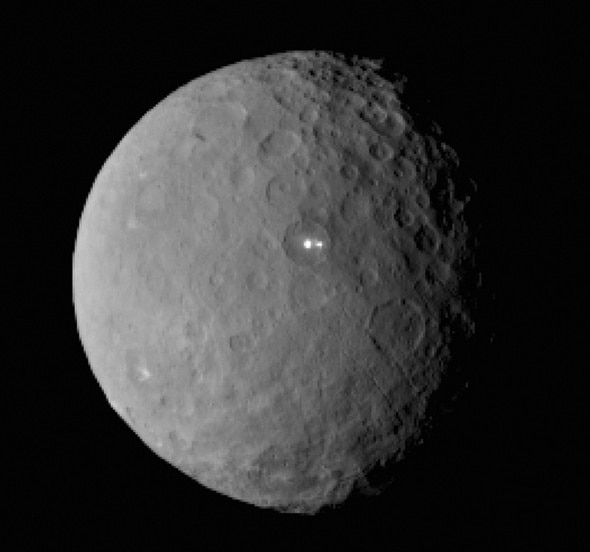Create a free profile to get unlimited access to exclusive videos, sweepstakes, and more!
Where Are the Pictures of Ceres?

I’ve been getting some emails and tweets asking why, if the Dawn spacecraft entered orbit around Ceres on March 6, haven’t we seen any new close-up pictures for nearly three weeks?
The answer is not that NASA is covering up alien bases or Obama’s birth certificate or any other such nonsense. It’s actually due to gravity and chemistry.
Dawn doesn’t use conventional chemical rocket thrusters. While these can provide a lot of oomph, the fuel is heavy, which means you need to carry more fuel to carry that fuel, and so on. You can change directions quickly, but the cost is dedicating more of your precious payload mass to fuel instead of scientific equipment.
Instead, Dawn uses ion thrusters, which use complex electric fields to fling ionized atoms out the back end at high speed. The thrust is a lot lower, but you use fuel so efficiently you can literally keep your engines on for months at a time. In the end, you get the same ability to change the direction and speed of your spacecraft; it’s just a lot more gentle and takes a lot longer.
So instead of blasting toward Ceres and blasting into orbit, it’s more like Dawn is sliding into orbit, catching up with the asteroid slowly and easing its way closer. To do that it flew past Ceres a bit, and is now on the side of Ceres away from the Sun. From its vantage point it’s looking down on the dark side of the asteroid. It’s also on a trajectory that took it farther away from Ceres, and is now falling down closer to it (like tossing a rock in the air, and having it fall back down into your hand).
In fact, a problem with Dawn’s reaction wheels (which are used to turn the spacecraft) caused engineers to put it on an orbital insertion path that’s even more fuel-efficient, to make sure they have extra fuel on hand if they need to compensate for the loss of the wheels. In September, a cosmic ray particle hit a part of Dawn's machinery that controls the ion propulsion, shutting it down. The spacecraft cruised for 95 hours when it was supposed to have been under thrust, forcing the need to change the incoming trajectory once the problem was fixed. The diagram above shows this, and here's a nifty animation of the insertion as well:So, though it’s been under the influence of the gravity of Ceres for a few weeks now, it’s not in a low orbit just yet. It will be soon though, and we’ll start getting lovely high-resolution images. I can’t wait. I’m dying to know just what those bright spots are; speculation is rampant among scientists, but really we won’t get definitive answers until Dawn gets close and can watch Ceres over time.
When will that finally start? April, so in just a couple of weeks. Patience, young Padawans. A new Ceres is coming.
Tip o' the electrostatic grid to Rachel WW for the link to the orbit video.
Correction, April 6, 2015, at 17:15 UTC: The new trajectory for Dawn's approach to Ceres was due to a malfunction triggered by a cosmic ray event, and not to conserve fuel for use to compensate for the reaction wheel loss as originally written. My thanks to my friend Preston Dyches for pointing this out.


























